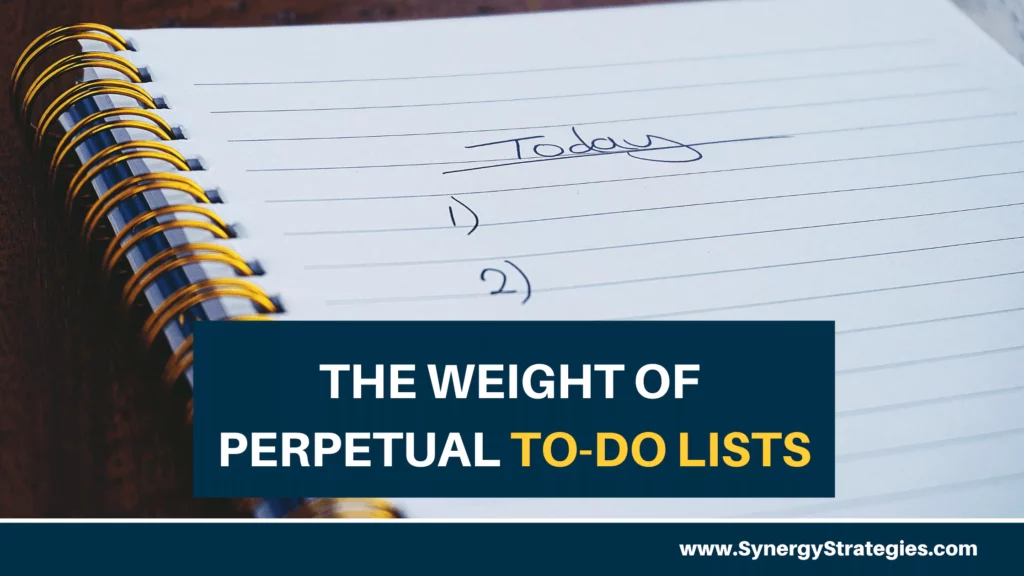I am biased, in that I LOVE to-do lists. I know some personalities do not really appreciate them quite as much as I do. Like them or not, neurologically, the human mind works better with a to-do list (see link). Behaviorally, humans are more productive with to-do lists. Statistically, according to www.trafft.com and their time management stat article, “70% of people use a to-do list to ensure that they get all their most important tasks done.”
(see more here: https://trafft.com/time-management-statistics/)
To do lists do help us to PLAN, ORGANIZE and EXECUTE! The challenge is there is an art to great to do lists.
A few tips:
- Tip #1: divide your to-do list into sections like home, work, and personal. When people mix tasks and you see home actions while at work, it distracts your ability to be present at work and to do home things when you need to do work things. It begins to fall into multitasking and reacting, which is less productive. I like to take a piece of paper and put a big PLUS in the middle, creating four quadrants representing four areas I have the most tasks. Another benefit from the quadrants is a general idea of WHEN you will do these times. All 20 items are not up for grabs all day long. Your work quadrant might be tasks you will do between 8-5, while your personal quadrant is things you would do from 6-8 AM, your home quadrant is things you would do that night from 6-9, etc.
- Tip #2: plan your to-do list the night before. Your brain will rest knowing the task is on paper but will subconsciously work to organize and prepare so when it comes time to do the item your brain is ready to go. In contrast when people plan the morning of, it is better than not planning at all, but now your brain is working harder to figure out what to do when and can take up valuable execution time figuring out what to do first then just getting into action
- Tip #3: put actionable items on your to-do list vs projects. Projects need to go someplace else, as this is a bigger picture of what you are doing. Your to-do list is for actionable steps (call, order, finish, etc.). Projects tend to overwhelm people, have LOTS of to-dos in one item (making it difficult to check it off the list), and end up being a perpetual item on the list because “purging the office closet” probably isn’t a 10 or even 60m tasks. Find the micro-task for the project and put that on the to-do list so you can experience progress, which fuels success and the energy of momentum.
- Tip #4: allow a mid-day update to your to-do list and your plan for the day.
- You might have thought about things that need to be added to the list; take time to add them. Carrying things in your mind is generally unproductive because it takes up brain space that is needed to get things done. Write it down so you can close that window, so to speak, and focus on the task and not remember to do XYZ when you get home. I often think about this like a computer and the more windows you have open, the slower your system will run. Our minds are very similar.
- Check off things that are done. This is a great chance to see if you have already gotten sucked into distractions and have NOTHING from your list done. This allows you to reorganize and double down in the afternoon. You might have been super productive and now that those items are off your list, the next layer of work tasks reveal themselves. The reality is, even with a to-do list, we only have the energy to think and process so many things at one time, so clearing things off the list is critical to get to the “next level” of actions that are waiting for an open seat.
- Updating the list allows you to see where you are at and create a plan for the next block of time. It makes you more productive and able to move faster. An example might be if you ran into the grocery for 4 items and lunch and after work. You could reasonably carry the 4 items for each quick pop-in. If you only went one time at the end of the day, you would struggle to carry the 8 items. Now while 2 trips to the grocery is not a good use of time, the purpose of this illustration is about how much we carry at one time. You want to carry a smaller load in your mind (ie TASKS), do them, and then reset vs holding all of them all day and then processing at the end of the day. Often by that point things are “falling off the radar” because it is just too much to hold. Plus, a day, much like a shopping trip, often has unexpected add on’s that contribute even more to the load, making it nearly impossible to carry it all at once. That lunch reset allows you to clear the queue and have great capacity for a productive afternoon.
- Tip #5: Put tasks on your list that you are going to do today. Make a task list for the week and roughly sketch out tasks for the week (assign tasks to days where you have open time blocks to do them). Tasks that need to be done but cannot happen today or this week, put in a “next week” queue or a “this month” queue or the parking lot. Planning your week is as important as planning your day. Both are critical for productivity. (rule of thumb: 10m to plan a day; 1 hour to plan a week; 1 day to plan a month; 1 week to plan a year)
- The reality is sometimes there are tasks on the list that don’t get done. We must be honest about what goes on our list and either make it a priority to get it done or plan a time that it will reasonably get done. They roll to the next day, and then the next day, and so on. These get heavy. They take up emotional energy and have weight. Think about every task on your to-do list as a 10lb weight. You can see why some people don’t like to make to-do lists – just acknowledging everything can be exhausting (but don’t let that deter you from making a list – the best and fastest way to lighten the load is to make a list and get things checked off). The point is that tasks carry some level of weight. The longer they are on the list is like holding a 10lb weight for an hour, it will soon feel like that 10lb weight weights like 25lbs as we fatigue from carrying it. This is how our mental energy works as well. Tasks that stay on the to-do list for a long period of time become heavy and stressful. We feel pressure and burden having them on the list, while we feel conflicted and stressed about how to get it all done. This usually tops to overwhelm where people shut down and procrastinate doing non-essential tasks and get putsy doing things that don’t move the needle but feel like something is happening (aka: procrastination). To avoid this, plan your day with tasks that you are committed to get done. Know sometimes those tasks might role to the next day, but it should not be more than 10-20% of the tasks. Tasks that repeatedly are on the to-do list need assessment.
- Is this a project and needs to be on a project list but needs smaller tasks for the to-do list?
- Is there something that is overwhelming me about this task that is causing me to procrastinate and not do it?
- When is reasonable that I CAN do it? (Plan a future day and time to do it that has enough time and the tools/info to do it)
- Make sure to communicate and co-design with people if they are expecting you to do a task but you have needed to put it in a queue or parking lot so they know you will not be getting to it anytime soon.
- Give yourself deadlines even for your personal tasks.
- Plan not only your day (but if you are not planning start with planning your day) but work to planning your week and month. When planning a week, you can look at your schedule and look at what tasks could reasonably be done in what “openings” on your schedule. When planning your month, create a list of what you need to do this month, and for bigger things block days for diving into a project (this is where you can block time for projects – but when you get to the day, you would break down the tasks for the project vs just saying this is a project day – you what to know exactly what will you do in the project day and make that to-do list).
- The reality is sometimes there are tasks on the list that don’t get done. We must be honest about what goes on our list and either make it a priority to get it done or plan a time that it will reasonably get done. They roll to the next day, and then the next day, and so on. These get heavy. They take up emotional energy and have weight. Think about every task on your to-do list as a 10lb weight. You can see why some people don’t like to make to-do lists – just acknowledging everything can be exhausting (but don’t let that deter you from making a list – the best and fastest way to lighten the load is to make a list and get things checked off). The point is that tasks carry some level of weight. The longer they are on the list is like holding a 10lb weight for an hour, it will soon feel like that 10lb weight weights like 25lbs as we fatigue from carrying it. This is how our mental energy works as well. Tasks that stay on the to-do list for a long period of time become heavy and stressful. We feel pressure and burden having them on the list, while we feel conflicted and stressed about how to get it all done. This usually tops to overwhelm where people shut down and procrastinate doing non-essential tasks and get putsy doing things that don’t move the needle but feel like something is happening (aka: procrastination). To avoid this, plan your day with tasks that you are committed to get done. Know sometimes those tasks might role to the next day, but it should not be more than 10-20% of the tasks. Tasks that repeatedly are on the to-do list need assessment.
Add Your Heading Text Here
To-do lists are critical for productivity and performance. They are key to momentum and success. It doesn’t matter if you have a paper or digital to-do list – whatever your system is, have a system and use it – DAILY. You will be amazed at the brain space you get, the reduced stress you feel, and the number of items you are able to get done!
Let me know how it goes and what tips or ideas you have to accelerate and support you being at your highest level!






